Review: Folkoperan and Cirkus Cirkör's Astounding Production of Satyagraha Lifts Philip Glass' Opera to New Heights
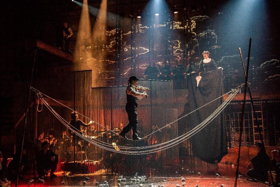
Composer Philip Glass has always been ahead of his time, perhaps even to himself (he has noted that a piece he created nearly half a century ago that he recently played at Carnegie Hall would have "freaked out" a 31-year-old Glass). Renowned psychologist Carl Jung's Red Book -- an illuminated manuscript with illustrations of his "active imaginations" was deemed so dangerous and esoteric (even by himself) that it was not published until 2009. Vincent Van Gogh was never appreciated in his lifetime but gained enormous fame thereafter. Glass could have been destined to be one of those artists who was never fully appreciated until after he had passed. Fortunately -- despite critics and those who scorn or cannot grasp his work -- this is not the case, as Glass is generally successful and renowned, but the collaboration formed between Swedish companies Folkoperan and Cirkus Cirkör to create the most visionary and fantastic, moving and inspiring production of Glass' sometimes misunderstood masterpiece, the opera Satyagraha, has elevated the work to astounding new heights and granted the music its visual match, equally as enchanting, outrageous, daring and utterly mesmerizing as score itself.
Glass' style is rebellious in nature, a kind of prog-rock or punk rock answer to contemporary classical music (the Frank Zappa-type of the classical world, if you will). In the same way, contemporary circus aims to uplift the artform from its lowbrow expectations shaped from the Barnum and Bailey days to the aesthetic of high art. Anyone fortunate enough to witness this production of Satyagraha as a part of BAM's Next Wave Festival (the last curated by the legendary tastemaker Joe Melillo) will be spoilt to ever encountering another version of this opera more compelling or perhaps any opera more modern and timeless in its execution for that matter.
This production is a full-circle "homecoming", as New York City first saw Satyagraha in 1981 when then BAM President & Executive Producer Harvey Lichtenstein inaugurated a new series of avant-garde performing arts that would become the Next Wave Festival. Glass' opera, which premiered one year earlier in Rotterdam would cement BAM's reputation as the home base of large-scale theatrical works by this quintessential American composer. Likewise there was a sense of serendipity and feeling of a completed circle for the the two female artistic directors and collaborators on the production -- Mellika Melouani Melani of Folkoperan and Tilde Björfors of Cirkus Cirkör -- when the desperate search for another opera to stage with a circus aesthetic occured after they'd lost the rights to represent Puccini's final work, Turandot, in such a manner. Instead, they left behind the Italian braggadocio and turned to the 20th century minimalist opera about Mahatma Gandhi's time in transformative South Africa more befitting of both Folkoperan and Cirkus Cirkör to make opera and circus accessible and resonating to modern audiences. At a time when we need to be reminded of heroes (both real and mythical) who stood up for justice despite all odds, Glass' Satyagraha is the ideal, if unexpected, choice.
The term "Satyagraha", was coined and developed by Mahatma Gandhi as part of a philosophy and practice within nonviolent or civil resistance and refers to "insistence on truth" or holding onto truth or truth force. The title that harkens to Gandhi's legendary peaceful resistance against the dominant and racist forces while in South Africa over a hundred years ago that shaped the rest of his life and activism, could not be more relevant today but has been made timeless through Glass' entrancing score with a book by him and Constance DeJong (also the librettist) adapted from the Indian holy text, The Bhagavad Gita, in which the preserver god, Lord Krishna, instructs Prince Arjuna in the art of war, largely perceived as a metaphor for the internal as much as external battles all human beings face.
The opera is presented in three acts (which breeze by in this captivating, edge-of-your-seat production), each named for three other revolutionary leaders: Leo Tolstoy, Russian author and non-violence advocating "Christian anarchist"; Rabindranath Tagore, Nobel Prize-winning Indian author who opposed British colonial rule; and Martin Luther King Jr. the peaceful protest leader of the Civil Rights movement in America. Though the powerful figures are never seen, their presence (as well as others like them farther back in history and shining examples of the present and into the future) is felt.
The irony is that this production began with a disclaimer warning the audience that the opera would be sung completely in Sanskrit and would not be an "A to Z" narrative, nor would the characters keep within their roles or definitions -- Gandhi may become Lord Krishna, a circus performer may be Gandhi. However the intent and intensity of this statement were offset by the fact that to the viewers -- I would even recon novices, early or first-time opera-goers -- that this was one of the most compelling and digestible operas even seen in any language -- particularly the complex musical vocabulary of Philip Glass.
For - at its best - the artform of contemporary circus is the same as Glass' music: rooted in repetitive motions, rigorous discipline and structure only to give the appearance of ease, being "light as air", fluid and so engrossing to watch or listen becomes utterly meditative.
Partially due to the space constrictions of their native theater in Sweden and limitations of rehearsal space, the production puts the vocalists (both soloists and chorus) with the acrobats and instrumentalists (reduced to 21 and arranged by Anders Högstedt with musical direction and conduction by Matthew Wood) together on BAM's smaller Harvey Theater stage (notably not the Howard Gilman Opera House), to create a more intimate and communal feeling one rarely experiences in an opera or circus. The acrobats, who at times serve as the soloists' doubles, are utilized to create the visual enchantment, and also to illuminate the non-linear scope of the performance.
Their contribution is the most exquisite complement to the spiritually elevated, heroic music resplendent with flurries of arpeggios and meditative repetition of phrases in the ancient language of holy writ -- the Bhagavad Gita. Guided by the visionary direction of Cirkus Cirkör's founder and Artistic Director, Tilde Bjorförs, the acrobats and circus specialists performed acts of seemingly inhuman feats of strength, trust, discipline and especially -- balance, much like Gandhi and his Satyagraha followers had to practice. In this context and understanding, the over-the-top circus acts feel anything but melodramatic, but instead they serve as poignant imagery and visual portrayals of the strain and suffering these revolutionaries faced. The see-saw catapults bodies into the air, leaps and flips become a testing ground for what colonizing Europeans made the Indians in South Africa (and the native South Africans of course) do backflips for; the tightrope become the thin and fragile line Gandhi had to walk, plummeted with adversity (symbolized by wadded up paper thrown at the Cirkör performer Alexander Weibel Weibel, who mirrored the tenor playing Gandhi, Leif Aruhn-Solen); the Cyr wheel as the wheel of time, transition and change, the aerial silks symbolic of mastery of self, control over nature and also acceptance of the fixed elements and transient nature of all things; and most of all -- the pervasive theme and demonstration of balance -- acts of hand-balancing, contortion and person-to-person feats of balance that portrayed and evoked visualizations of strength, resilience, perseverance and most of all trust and egolessness -- all pillars that Gandhi taught and lived.
The representation of yarn is a strong and important theme throughout (the knitted scenery was provided by Aino Ihanainen) serving as the visual unifier and the symbol of India's independence (a concept Gandhi himself promoted). In contrast to the intensity and conflict often felt sonically and visually, the yarn often spun the vision of peace and harmony through living simply most craved by the Satyagraha community (Act 1, Scene 2: The Tolstoy Farm). Those very strings were the thread of a throughline of the whole production that concluded in the cast feeding fibers to an aerial apparatus from above that appeared to transform into a loom or cycle (representing setting into motion the "wheel of action" mentioned in the holy text by Lord Krishna) demonstrating our parts in what Hindus and Buddhist call Samsara or "The Wheel of Life."
Unlike the grand bombast and melodramatic expressions (or the dreaded "park and bark") often associated with opera singers, these phenomenal angelic voices carried the message of the inner and outward journey for truth and justice to the heavens with their gentleness and subtleties in both movement and musicality. This is particularly true of Leif Aruhn-Solen whose portrayal of Gandhi is the epitome of peace. They all sing the sacred text with supreme reverence that resonates deeply on an emotional level.
The emotional depth and complexity turns to pure inspiration when the beauty of the ancient language is guided by a few select translations that are projected and thus imprinted into the mind and heart as mantras and words of wisdom such as: "He who renounces actions merely because of difficulty, or out of fear or physical pain, thereby acts only in self-interest and is not on the path of truth" or "Hold pleasure and pain to be alike, likewise gain and loss, victory and defeat. Thus engage in battle!"
But the most powerful call to action is carried on Glass' transcendental tones -- an array of arpeggios and ostinatos, constantly transitioning time signatures flowing like wind rustling through autumn leaves, or a soft drizzle of rain -- arousing feelings of heroism and a enlightened nature as they evoke nature itself in the last number. This is the finale, the ending song of Act 3 and is perhaps the most famous piece not only in Satyagraha but one of the most known and beloved in Philip Glass' entire catalogue. The words (sung in Sanskrit with English notes) are a beacon of hope that Lord Krishna (as Gandhi) delivers to his devotee: "Arjuna! Whenever there is a decline of righteousness, and the rise of unrighteousness, then I manifest Myself again. For the protection of good and destruction of evil doers, the sake of establishing righteousness, I come into being from age to age." The concept of returning to samsara the "vale of tears" to aide others in freedom from suffering and the causes of suffering is embodied in the form of a Bodhisattva or "enlightened being" in Sanskrit. They are believed to take many forms, including posing as ordinary human beings.
The multitude of these unexpected dynamics -- from ancient script to circus arts and minimalistic, repetitive sounds that are seemingly simple but truly complex -- when spun together have woven an experience with such depth and power it is breathtakingly inspiring. This production is a true testament to the incredible capacity of a human being: mind, body, soul and a reminder that these grand themes lie within simplicity and humility teamed with diligence, devotion and a unshakable spirit -- something that Gandhi, King, Tagore, Tolstoy and every single person involved with this production embodies to the fullest.
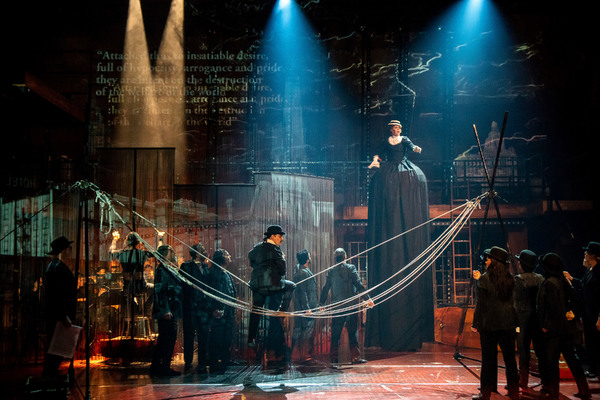
Alexander Weibel Weibel and Karolina Blixt in the Folkoperan/ Cirkus Cirkor production of Philip Glass' Opera "Satyagraha" at the BAM Harvey Theater on October 31-November 4, 2018, part of the Next Wave Festival. Photo Credit: Stephanie Berger.
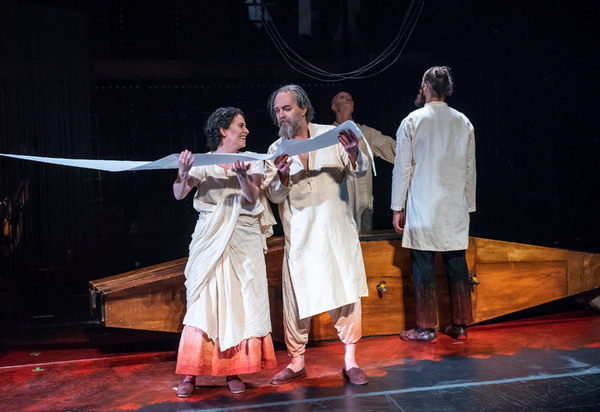
Karolina Blixt and Johan Schinkler in the Folkoperan/ Cirkus Cirkor production of Philip Glass' Opera "Satyagraha" at the BAM Harvey Theater on October 31-November 4, 2018, part of the Next Wave Festival. Photo Credit: Stephanie Berger.
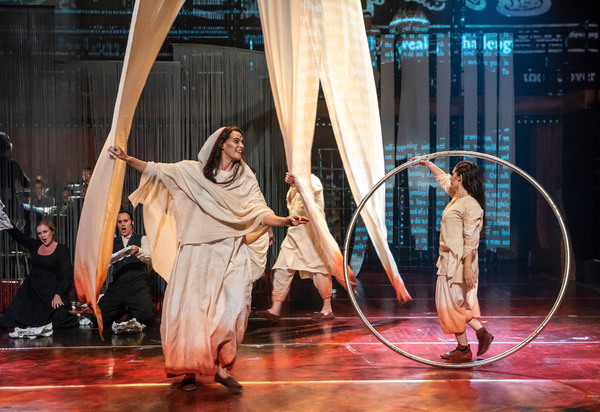
Karolina Blixt and Sarah Lett in the Folkoperan/ Cirkus Cirkor production of Philip Glass' Opera "Satyagraha" at the BAM Harvey Theater on October 31-November 4, 2018, part of the Next Wave Festival. Photo Credit: Stephanie Berger.

Sarah Lett in the Folkoperan/ Cirkus Cirkor production of Philip Glass' Opera "Satyagraha" at the BAM Harvey Theater on October 31-November 4, 2018, part of the Next Wave Festival. Photo Credit: Stephanie Berger.
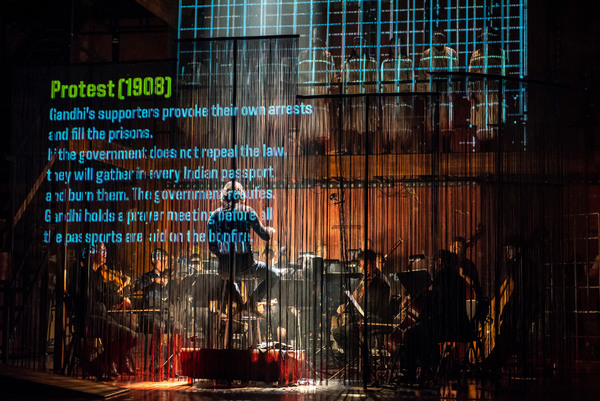
Folkoperan/ Cirkus Cirkor perform Philip Glass' Opera "Satyagraha" at the BAM Harvey Theater on October 31-November 4, 2018, part of the Next Wave Festival. Photo Credit: Stephanie Berger.

Leif Aruhn-Solen as Gandhi in the Folkoperan/ Cirkus Cirkor production of Philip Glass' Opera "Satyagraha" at the BAM Harvey Theater on October 31-November 4, 2018, part of the Next Wave Festival. Photo Credit: Stephanie Berger.

Karolina Blixt, Johan Schinkler and Hanna Fritzon in the Folkoperan/ Cirkus Cirkor production of Philip Glass' Opera "Satyagraha" at the BAM Harvey Theater on October 31-November 4, 2018, part of the Next Wave Festival. Photo Credit: Stephanie Berger.
Reader Reviews

Videos


